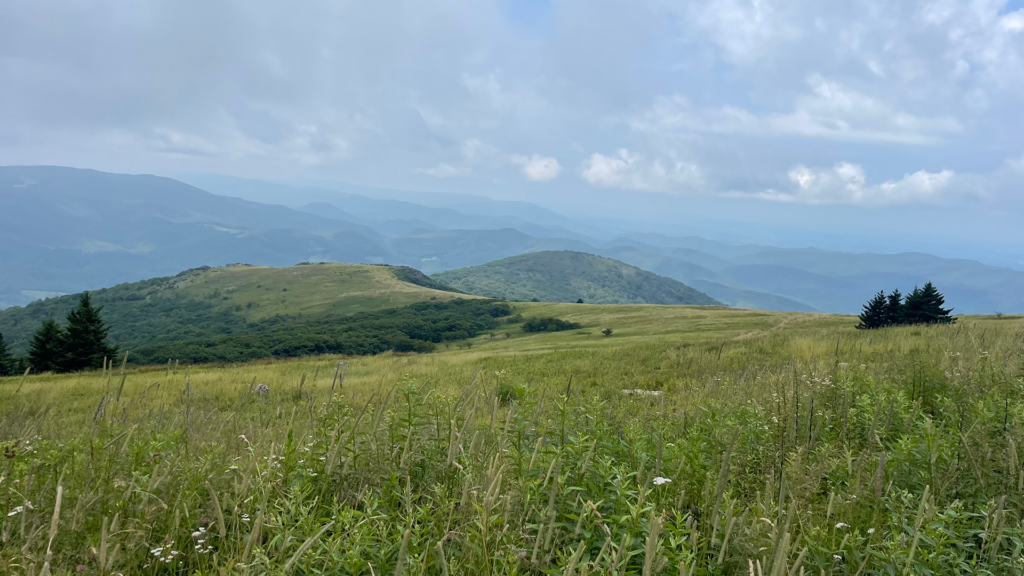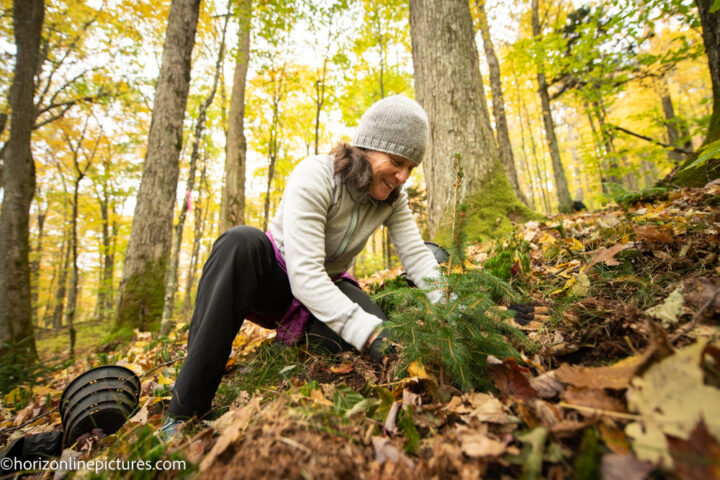By Sophia Pasquariello, ATC Social Media Intern
Early Successional Habitats on the A.T.
April 23, 2024
The Appalachian Trail (A.T.) is a marvel of natural beauty and an example of what is possible when a group of dedicated people make a commitment to safeguarding nature for future generations. Stretching over 2,198 miles from Georgia to Maine, the Trail winds through marshlands, dense forests, meadows, and even alpine balds and grasslands, displaying a diverse range of Appalachian ecosystems.
In addition to these unique biomes, the A.T. also weaves in between a different, more concrete habitat — the built environment where more than two-thirds of the U.S. population lives within a single day’s drive to the Trail. Many A.T. hikers escape the built environment to journey through this incredible protected corridor for scenic panoramic views, to hike along cool mountain streams, or to see unique wildlife that does not exist in the built environment.
One declining habitat type that provides both scenic and wildlife benefits is early successional habitats. Managing early successional habitat is a key part of the ATC’s work to protect the Trail and the species that call the A.T. corridor home.
Understanding Early Successional Habitats
All habitat types are in a constant state of change, and early successional habitats are areas that are in an important part of that change cycle. Early successional habitat is characterized by specific structural and species composition; generally, forbs, grasses and herbaceous species. Trees and shrubs, depending on the stage of succession, are often absent or are just beginning to grow on the landscape.

A bald along the A.T. on Whitetop Mountain in Virginia shows the openness of early successional habitat.
Sometimes ecosystems are in the early successional stage of change because of natural events like wildfires, storms, or flooding, or because of animals like large herbivores. Early successional habitats may also be the result of landscape change that is brought on by human activity like agriculture or development.
Max Patch is a well-known example, often linked to dispersed camping atop the popular bald and visitors creating many social trails across the grassy peak.
The Importance of Early Successional Habitats
Different Species Dependency
For many species, such as golden-winged warblers, Eastern meadowlarks, bobolinks, and native bumblebees, these habitats offer a unique sanctuary that is more open than forests. The unique conditions of early successional areas are important for these species’ survival, providing them with the necessary resources to thrive.

Photo of a wildlife opening maintained for wild turkey and pollinators near the A.T. corridor in Pennsylvania.
Environmental Benefits
These habitats are not just crucial for wildlife; they play a significant role in the forest’s recovery process. These areas help many different plants and animals grow back and become stronger, making the ecosystem healthier.
Additionally, native grasslands and young growth forests have the potential to sequester carbon at faster rates than many other areas, meaning that managing early successional habitats benefits the planet as a whole by capturing excess carbon.
Recreational and Aesthetic Value
For hikers and nature enthusiasts, early successional habitats enhance the outdoor experience, offering unique landscapes and the chance to observe a variety of wildlife and seasonal colors that might not be as common in older forests. Think of the views that might be unique to more open sections of the Trail, or the opportunity for wildlife spotting that these areas may provide. Many of the early successional meadow habitats maintained by the ATC along the Trail are on ridges and mountain tops, also affording visitors exceptional opportunities for taking in expansive views.

Photo of the Hop Brook meadow through which the A.T. passes in Massachusetts.
The Appalachian Trail Conservancy’s Efforts
Conservation and Management
The ATC, along with partners like the U.S. Forest Service, has taken steps to manage and restore these habitats. In areas like Max Patch, work focuses on reforesting areas that were heavily impacted by resource extraction and recreation.
You might be wondering, if early successional habitat is a natural part of ecosystem change, why don’t land managers just allow these places to run their natural course and mature into forest? While on a landscape untouched by humans (which are none of the landscapes near the A.T. corridor) these early successional areas would frequently come and go across the landscape as natural fires started, predators pushed large herbivores across the land, and native species grew without competition from invasive species.
However, that untouched landscape and natural process no longer exists due to the loss of top predators, fire suppression, invasive species, and human intervention. So, land managers must now maintain these areas that would otherwise disappear from the landscape altogether and with them, the many species that depend on them.
Education and Awareness
Raising awareness about the significance of these habitats is another crucial step. The ATC has introduced educational materials (like this blog post!) to inform the public about the importance of these areas and how to minimize human impact. These efforts are designed not only to protect the habitats but to help visitors better understand and appreciate these vibrant landscapes.
How to Get Involved
Volunteering
The ATC encourages everyone who loves the A.T. to play a part through volunteering. Help care for crucial habitat near you by finding an opportunity to volunteer with your local Trail Club.
Support
Donations are critical for continuing these essential conservation efforts. Every contribution helps ensure that the A.T. and its diverse habitats remain preserved and accessible for years to come.
Early successional habitats are a crucial part of the Appalachian Trail’s variety of nature. Their protection is essential not only for the species that rely on them but for the health of the broader ecosystem, and the enjoyment of future generations of hikers. To further enhance ecological diversity and resilience, The ATC maintains a mosaic of habitats along the trail. This mosaic includes various habitats, each supporting different types of wildlife and unique ways. By caring for this changing landscape, we can ensure it remains healthy and enjoyable for everyone.
Discover More

OUR WORK
Science & Stewardship
Appalachian Trail management encompasses the on-the-ground stewardship performed by volunteers and agency partners to maintain the Trail, its structures, and its natural and cultural resources.

Partners in Conservation
Landscape Conservation
The Appalachian Trail landscape conservation requires many partners to connect the wild, scenic and cultural wonders of the A.T. and its surrounding landscape.

Official Blog
An A.T. Realm Beyond Recreation
Recreation is only one part of a broader Appalachian Trail conservation effort, which extends well beyond the footpath itself.
